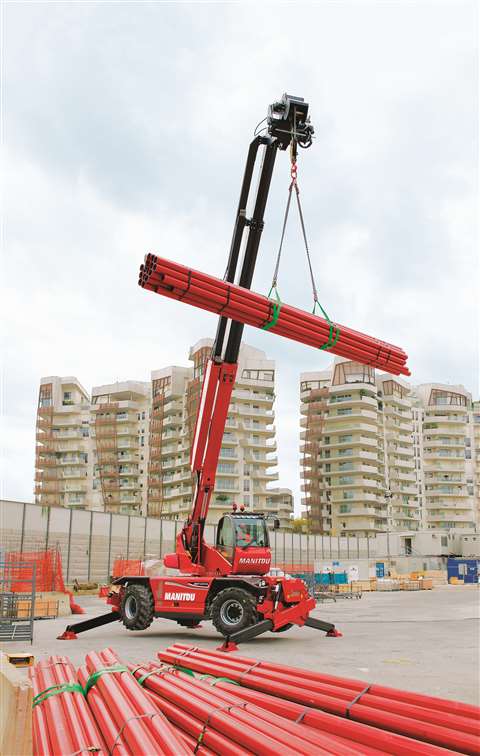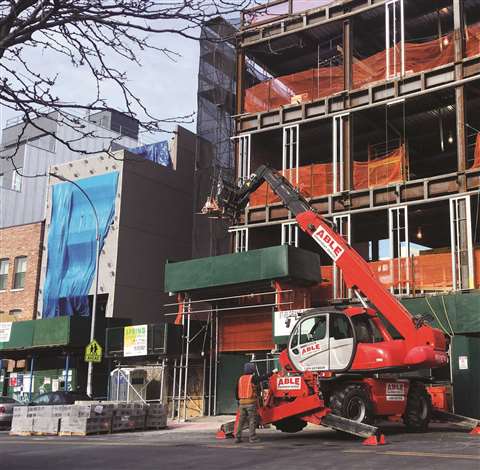Rotating Telehandlers: Spin cycle
16 August 2017

They’re efficient and speedy. Productive and safe. Yet despite the many benefits rotating telehandlers offer end users, the acceptance of the machines on jobsites and in fleets has been somewhat sluggish.
“The market has been slow in adapting to the rotating telehandler market over the past five years but we have seen that change over the past 12 months,” says Brian DePaul, vice president of sales and marketing for Dieci Equipment USA. “They are becoming more commonly accepted throughout the country.”
Dieci Equipment USA, based in Pennsylvania, was formed in 2014 and is an importer of Italian-built Dieci telehandlers. The company most recently introduced the Pegasus 45.30 to the North American market. The unit has a 9,921 pound lift capacity and a 97-foot lift height. It rotates 360 degrees and features a FPT 127 hp turbocharged diesel engine. The unit can travel up to 25 mph and has anti-tipping protection with stabilizers. DePaul says rotating telehandlers offer versatility and productivity while reducing space required on a jobsite.
“I expect rapid growth in the rotational telehandler business throughout the country over the next 18 months,” he says. “They will become more accepted with more education on the benefits.”
And, boy, are there benefits. Rotating telehandlers offer numerous possibilities when users consider the various types of carriages, +/- 10-degree tilt, rotation of up to 400 degrees, buckets, hooks, double hooks with a jib, winches up to 12,000 pounds and more.

Philippe Bisson, senior business development manager at Manitou Group, says he has seen an increase in interest and requests for these units.
“As the construction industry has bounced back from 2008, contractors are looking for ways to improve their productivity and profitability and the rotating telehandler offers them this opportunity, especially if they require cranes on their jobsites,” Bisson says. “In the next 18 months, I expect the demand to double. As more and more contractors and companies are using this technology and realizing the benefits of having one unit perform the job of three or four others, the word of mouth is spreading and we have seen quite an increase in sales and rentals throughout our network just over the last six to 12 months.”
Manitou, which recently debuted its MRT3050 that can lift 11,000 pounds and reach 96 feet, also boasts its Manitou attachment system that immediately recognizes the attachment and then pulls up the load chart onto the display system.
“The unit will then provide the capacity of the unit for every mode used, whether on wheel, cabin straight, cabin rotated or on full or partial outriggers and the operator will be able to see what attachment is connected to the boom and the capacity available as the turret is turned, boom lifted or lowered, expended or retracted,” Bisson says. “If the maximum capacity is reached at any time, the operator will get a warning signal preventing them to pursue until they are back in a safe operating range.”
As a whole, Manitou has witnessed steady growth and interest since they entered the rotating telehandler market more than 30 years ago, says Steve Kiskunas, product manager of telehandlers at the company.
“The last three years have been very active and we expect that trend to continue,” Kiskunas says. “We expect to see the use and purchase of rotating telescopic handlers to continue to grow in the next 18 months.”

Manitou expects demand for rotating telehandlers to double in the next 18 months.
For Canadian-based Manulift, which imports Italian Merlo machines, the market has seen steady and slow growth – and they are positive it will continue in such fashion.
“[The market] will continue to grow, there is no turning back,” says Michel Robert, marketing and communications director at Manulift. “Education is the key for acceptability and getting the most from a rotating telehandler; this is why at Manulift we put together formal training for our rotating units.
“It is a complex machine and without the proper training, you won’t get the most performance from it. It’s like changing from a regular to smart phone; at the beginning you want to go back because it was easier, however after three months, you depend on it so much that you would never go back.”
More bang for your buck
“[Our units] provide customers with tremendous cost savings, efficiency, ability to work in tight spaces and safety,” says Gary Weisman with Paramount Equipment and Magni Telescopic Handlers. “Magni rotators just get the work done faster. This results in cost savings for the contractor which means greater profits and/or the ability to bid more competitively. The ability to work efficiently by eliminating machines on a jobsite and getting work done faster means the G.C. is going to be very happy with the work performed. With a small footprint and the ability to rotate continuously 360-degrees in either direction, Magnis work great in tight spaces where other machines cannot. In today’s environment, safety is top of mind on most every jobsite. Magni’s world leading advanced technology virtually eliminates operator mistakes resulting is damage and injury.”
Paramount imports Italian-built Magni telehandlers. Weisman, like others, admits growth has been steady but slow. “Despite the tremendous value proposition and clear advantages of rotating telehandlers, pioneering a product is not easy and most manufacturers do not have the focus needed to really get traction,” Weisman says. “At Magni, because rotators have traditionally been our only business – we introduced our first straight telehandler this year – we are hard at work blazing the trail. The results have been very positive and our growth rate is in the triple digits.”
Magni has seen an increase in its dealer network and number of machines in the field. The company also reports it has had highly positive responses from end users. Because of this, Magni is forecasting triple digit growth over the next 18 months.
But will these spin masters ever be as utilized in North America as they are in Europe?
“The European construction market is different from North America,” Kiskunas says. “We do expect the use of rotating telehandlers to continue to grow in North America, but it is not expected to be the same as Europe. This is due to building practices and the equipment supply markets more than the product.”
Robert, with Manulift, disagrees.
“It will take time, but yes I believe rotating telehandlers will be as popular in North America as they are in Europe,” he says. “As time goes on and working space diminishes on jobsites, like in Europe, the need for compact units able to reach 60 feet and more will grow – therefore the rotating telehandler will gain in popularity.”
Most dealers and manufacturers say it is undeniable that most any trade can benefit from these units. Weisman believes rotating telehandlers will, eventually, shine.
“The results users receive are savings, safety and efficiency,” Weisman says. “What we’ve seen is that once an end user gets into a Magni, they rarely give it back. In addition, the feedback from owners has been very strong.”
DePaul isn’t quite so sure. “They will certainly see consistent growth moving forward, but I am not sure it will ever be as big as it is in Europe,” he says. “I am hopeful that we will one day experience the popularity like Europe.”
According to Ali Lawton, sales and regional manager for Imperial Crane Services, feedback from customers has been extremely positive and the units are gaining traction.

Imperial Crane Services has invested in Merlo telehandlers to work in Industrial, commercial and residential construction, utilities, petrochemical and manufacturing facilities.
“We have people calling us when they see one of our Merlos on a jobsite,” Lawton says. “I think the overall use will undoubtedly increase as more of these machines are being used and end users are realizing their true potential.”
Imperial Crane Services, as the name would suggest, is a crane rental company. They have invested in Merlo telehandlers to work in industrial, commercial and residential construction, utilities, petrochemical and manufacturing facilities.
The company says rotating telehandlers offer a wealth of advantages over a traditional telehandler.
“It gives users more options,” Lawton says about a rotators. “Sometimes our customers have space limitations on the jobsite and cannot use conventional telehandler as it needs room to maneuver, while a rotating telehandler can offload a truck to exactly where it needs to go whether it be up in a structure or somewhere else on the site, while sitting on its outriggers – and it does this faster than a conventional telehandler would while also being safer due to the fact they are not driving around a jobsite.”

Despite these benefits, Lawton does admit there is a learning curve in America when it comes to adaptation.
“Traditionally, the North American market is more cautious to adapt new technologies and machines, especially in the lifting industry, but once the market realizes the true utility and flexibility of these machines I think they will be extremely popular,” Lawton notes.
Get to work
Right now, primary markets for rotating telehandlers tend to lean toward urban areas where high reach is needed, and on projects where space is limited. Both factors play into the strengths of the rotating telehandlers.
“Large metro cities are where we see these units working, however I believe that will change and we will see more rotational machines going into rural markets in the future,” says DePaul. “A lot is due to restricted space and having to reach higher for tall buildings in the cities.”
For Manitou, the most common places are the Province of Quebec, especially in Montreal, New York City, Chicago and Los Angeles, mainly due to the dealer network’s footprint, they say. As for applications, masons, general contractors, framers and steel erectors have been the first ones embracing the units.
Afterall, a rotating telehandler acts as a telescopic forklift, rough terrain crane and a work platform. This results in reduced costs for logistics, rentals, operators, fuel, services and more. Also, with attachments, these units can be used to install glass, cut trees and drill rock.
“A standard telehandler is very useful on jobsites but it only does one thing: lift up and down, and not in the most efficient way,” Bisson says. “The rotating telehandler is very useful when working in tight areas, requiring lifting higher than 56 feet, in muddy and uneven terrain and busy environments. Because the rotating telehandler can rotate 360 degrees with multiple attachments, operate on outriggers and with a remote control, it offers many benefits the traditional telehandler simply can’t match.”
Weisman says, “Geographically, we see the scale tipping toward more urban areas. This is due to their ability to work great in tight spaces, reach ever greater heights and replace several machines with one. The applications are endless and often result in savings for the end user. In many cases, a Magni can replace the need for a crane on a jobsite.”
Earlier this year, Magni introduced the RTH 6.46 SH – a machine that can lift to a height of 150 feet, has a forward reach of 110 feet and has a lifting capacity of 13,200 pounds. In addition, at maximum height the machine can lift 5,500 pounds.
“There is nothing else like it,” Weisman laments. “The RTH 6.46 SH exceeds the lift height any other rotating telehandler in the market by 50 percent. In addition, Magni has re-engineered several existing models to allow for a higher lifting capacity of 13,200 pounds.”
STAY CONNECTED



Receive the information you need when you need it through our world-leading magazines, newsletters and daily briefings.
CONNECT WITH THE TEAM








